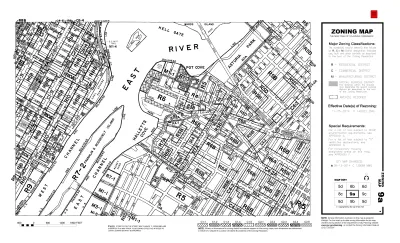According to Seymour Toll's 1969 book, New York City's 1916 zoning code was less a civic-minded project than an attempt to protect elite retail districts from the riff-raff. The ramifications for American zoning at large are significant.

For a short time during the late 1960s, Jake Blumgart writes, "zoning received the attention it deserved as a monumental force shaping the character of many American communities—in large part due to civil rights protests over its exclusionary effects in newer suburbs." Today, renewed debate about urban segregation has cast zoning into the spotlight once again.
In his 1969 book Zoned American, Seymour Toll gives us "an in-depth history of the 1916 New York code, the progenitor of zoning codes nationwide, and the impetus for its creation. The received history of zoning often frames it as a creation of Progressive-era good government planners. But Zoned American shows that the code was actually created as a weapon to defend the narrow self-interest of a small group of prestigious merchants."
In a move that presages problematic zoning later in the century, "wealthy retailers based along Fifth Avenue were the advance guard of zoning in New York. Dubbed the Fifth Avenue Association, they believed their investments would be compromised by the northward advance of the garment industry and the hordes of foreign born workers that accompanied it."
The zoning that emerged from these conditions had specific and recognizable prejudices. It sought to constrain density and height, separating uses to preserve "the northern stretch of Fifth Avenue—and Manhattan more generally—for businesses that catered to the wealthy."
Stephen Smith, well-known as the voice behind @MarketUrbanism on Twitter, remarked, '"There wasn't some grand plan, zoning was taking whatever was there and freezing it [...] Toll convinced me it wasn't really planning, it was just reacting to whatever was already built.'"
FULL STORY: Learning from 'Zoned American'

National Parks Layoffs Will Cause Communities to Lose Billions
Thousands of essential park workers were laid off this week, just before the busy spring break season.

Retro-silient?: America’s First “Eco-burb,” The Woodlands Turns 50
A master-planned community north of Houston offers lessons on green infrastructure and resilient design, but falls short of its founder’s lofty affordability and walkability goals.

Delivering for America Plan Will Downgrade Mail Service in at Least 49.5 Percent of Zip Codes
Republican and Democrat lawmakers criticize the plan for its disproportionate negative impact on rural communities.

Test News Post 1
This is a summary

Test News Headline 46
Test for the image on the front page.

Balancing Bombs and Butterflies: How the National Guard Protects a Rare Species
The National Guard at Fort Indiantown Gap uses GIS technology and land management strategies to balance military training with conservation efforts, ensuring the survival of the rare eastern regal fritillary butterfly.
Urban Design for Planners 1: Software Tools
This six-course series explores essential urban design concepts using open source software and equips planners with the tools they need to participate fully in the urban design process.
Planning for Universal Design
Learn the tools for implementing Universal Design in planning regulations.
EMC Planning Group, Inc.
Planetizen
Planetizen
Mpact (formerly Rail~Volution)
Great Falls Development Authority, Inc.
HUDs Office of Policy Development and Research
NYU Wagner Graduate School of Public Service





























